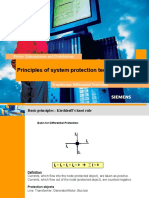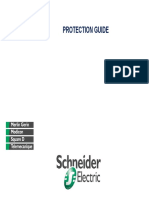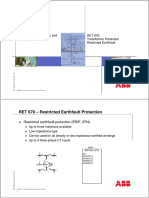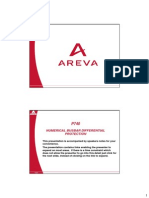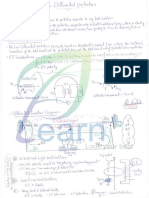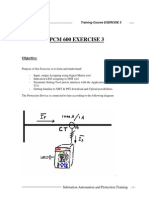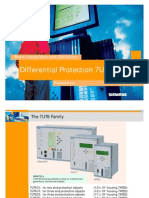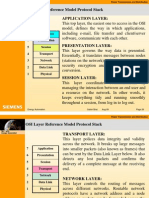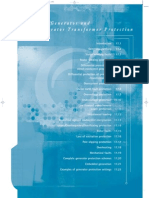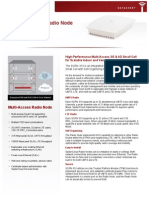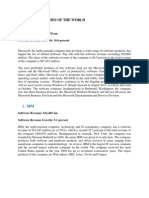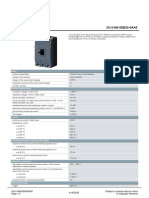Power Transmission and Distribution
Principles of system protection technology
Transformer Differential Protection
�Basic principles : Kirchhoffs knot rule
Basis for Differential-Protection:
I1
I2
I4
I3
I1 + I2 + I3 + I4 = 0 ? ? I = 0
Definition:
Currents, which flow into the knot (protected object), are counted positive.
Currents, which flow out of the knot (protected object), are counted negative.
Protection objects:
Line, Transformer, Generator/Motor, Bus bar
Principles Transf. Diff 2
�Basic principles: current comparison
IP1
IS1
I1F
Protected
object
IS1
?I
I2F
IP1
IP2
IS2
IS1
IP2
Protected
object
IF
IS2
IS2
?I
IDiff = I1 + I2
external fault or load
internal fault
Assumption: CT- ratio: 1/1
IP1 = I1F
IP2 = I2F
IDiff = IP1 + IP2 = I1F + I2F
? Trip
IDiff = I1 + I2
Assumption: CT- ratio: 1/1
IP1 = IF
IP2 = -IF
IDiff = IP1 + IP2 = IF - IF = 0
? no Trip
Requirements for Differential Protection:
1) Internal faults ( faults between CT-sets ) ? Trip
2) External faults ? no Trip
Principles Transf. Diff 3
�Basic principles : restrained current comparison
(1/2)
Example: external fault with linear CT-errors
IP1
Ct 1:
e1= - 5%
IS1=
0.95IP1
Protected
object
Ct 2:
e2 = +5%
IDiff = 0.1IP1
?I
IP2 = -IP1
IF
IS2=
1.05IP2
assumption: CT- ratio: 1/1
IDiff = IS1 + IS2 = (1+e1 ) IP1 + (1+e2)IP2 = 0.95 IP1 1.05 IP1 = 0.1IP1
-normal operation: IP1 = IN
IDiff = 0.1IP1 = 0.1I N
-external fault: assumption: IP1 = 10IN
IDiff = 0.1IP1 = 1IN
As the setting I Diff> for usual applications
lays below nominal current,
it would cause a wrong trip in case of
external faults with heavy current!
Restrained characteristic necessary!
Principles Transf. Diff 4
�Basic principles: restrained current comparison
(2/2)
Example: external fault with linear CT- errors
CT 1:
e1= - 5%
I P1
CT 2:
e2 = + 5%
Protected
object
IRest
I P2 = -I P1
IF
I Rest = I S1 + I S2
I Rest = 2I P1
I S2=
1.05I P2
I S1=
0.95I P1
IDiff
Setting due to
magnetising or
charging currents
I Diff=
I S1+I S2
I Diff= I S1+ I S2
I Diff = 0.1I P1
Linear error due to
different
CT transformation
Resulting
characteristic
IN
Trip
Block
I Diff>
2
10
I Rest = I S1 + I S2
Under the following
assumption
e1 = e2 and I1 = I2
the result for a conventional
Differential Prot. characteristic
should be:
IDiff = IDiff> + e1I1 + e2I2
= IDiff> + 2e1 I1
with IDiff> = setting
Principles Transf. Diff 5
�Basic principles: measuring circuit for a 3-phase system
Basic circuit for a 3- phase system:
Generator / Motor / Reactor
L1
L2
L3
Diff.
Rest. current
Conventional
Differential Protection
Principles Transf. Diff 6
�Transformer Differential Protection special qualities
Angle shifting N30 due to vector group (0 = N = 11)
for 3-phase transformers.
Different current values of the CT- sets on the high voltage side (HV)
and on the low voltage side (LV)
Zero sequence current in case of external faults will cause
differential current
Transformer-tap changer, magnetising current
Transient currents
Inrush
CT-saturation
Principles Transf. Diff 7
�3-phase Transformer: primary values
Load: 100MVA ,vector group: Yd5
side 2: 20kV, 2887A
side 1: 110kV, 525A
3000/1A
2L1
2L2
2L3
I2L1?
I2L2?
I2L3?
750/1A
I2*L1
?I1L1
I2*L2
?I1L2
I2*L3
?I1L3
1L1
1L2
1L3
kU = U1N /U2N = 110kV/20kV = 5.5
kWinding = w1/w2 = kU/v3
I2*L1 = -I1L1ku /v3 + I1L2ku /v3
I2*L3
I1L1k u/v3
I1L1
530
I2*L2
I1L2k u /v3
I1L3
I1L2
-I1L1k u /v3
I2*L1
Principles Transf. Diff 8
�3-phase Transformer : secondary values
I L1sec ?
SN
I
? NCT1sec
3 ?U N I NCTlprim
I1L1sec ?
100MVA 1A
?
? 0.7A
3 ?110kV 750A
I2 L1sec ?
I1L1sec= 0.7A , 0
100MVA 1A
?
? 0.96A
3 ?20kV 3000A
IDiff L1 = I1L1sec+ I2L1sec
= 0.5A
I2L1sec = 0.96A , -150
Principles Transf. Diff 9
�Vector group and current value adaptation in case of
conventional Transformer Differential Protection
3000/1A
Load: 100MVA ,vector group: YNd5
side 2: 20kV
side1: 110kV
(1/2)
ILoad=
525A
750/1A
L1
2887A
L2
L3
0.7A
0.96A
Diff.
IR
29
Wdg.
23
Wdg.
Rest. current
Conventional
Differential Prot.
Matching transformer
-Vector group adaptation
-Current value adaptation
-Zero seq. current handling
nominal Load (no fault): 0.70A 23Wdg = 0.555A 29Wdg,
IR = 0.555v3 = 0.96A
Principles Transf. Diff 10
�Vector group and current value adaptation in case of
conventional Transformer Differential Protection
3000/1A
~
~
Load: 100MVA ,vector group: YNd5
side 2: 20kV
side1: 110kV
(2/2)
750/1A
L1
13655A
L2
L3
3I0
4.55A
5.73A
Diff.
IR
29
Wdg.
IP=
4300A
23
Wdg.
Rest. current
Conventional
Differential Prot.
single pole fault HV -side:
Matching transformer
-Vector group adaptation
-Current value adaptation
-Zero seq. current handling
5.73A 23Wdg = 4.550A 29Wdg , IR = 4.55A
Principles Transf. Diff 11
�Vector group and current value adaptation in case of
numerical Transformer Differential Protection
CT 2
3000/1A
2L1
2L2
Load: 100MVA ,vector group: YNd5
side 2: 20kV
side 1: 110kV
I2 L1P ?
?I1 L1P
I2 L2P ?
?I1 L2P
I2 L3P ?
2L3
I2 L1S
I2 L2S
I2 L3S
(1/2)
CT 1
750/1A
1L1
1L2
?I1 L3P
I2 A
Current
Vector
Io
value
group
handling
I2 B
adaptation
adaptation
CT 2
I2 C
I1 A
comparison
?I
I1 B
Io
handling
I1 C
Current
value
adaptation
CT 1
1L3
I1 L1S
I1 L2S
I1 L3S
Numerical Transformer Differential Protection
Principles Transf. Diff 12
�Vector group and current value adaptation in case of
numerical Transformer Differential Protection
(2/2)
Parameterisation of transformer and CT- data
in a 7UT6 Differential Protection Device
Principles Transf. Diff 13
�Tripping characteristic of Transformer Differential Protection
CT-errors , Tap changer , Magnetising current
I Diff
InO
3.0
2.5
Trip
slope 2
Total error
2.0
Block
45
1.5
CT- error
1.0
slope 1
Tap changer error
0.5
IDiff>
0
Transf. magnetising current
0
1.0
Characteristic:
2.0
3.0
4.0
5.0
IDiff = f (IRest)
IRest = |I1| + |I2|
6.0
7.0
8.0
9.0
I Rest InO
InO = nominal current of the protected object
Principles Transf. Diff 14
�Transient currents (with Harmonics)
- Inrush of Transformers
even
2. Harm.
Inrush
(1 of 2)
iDiff = i1
i1
Y Y
t=0
i1
i2 = 0
t
even
2. Harm.
Inrush
iDiff = i1
i1
t=0
i1
I2 = 0
t
Connecting -T2 in parallel with -T1
(Sympathetic Inrush T1)
-T1
i1
t=0
Inrush -T2
-T2
i1
-T1: iDiff = i1
I2 = 0
t=0
t
Principles Transf. Diff 15
�Inrush, cross block, over excitation [V/Hz]
(2 of 2)
filter window
1 cycle
iRUSH
= iDiff
Cross-block = No (phase separate blocking)
Inrush current
in one phase
1P
I2har
IDiff
2P
IDiff, L1 > trip blocking
L2-block
IDiff, L2 > trip blocking
L3-block
IDiff, L3 > trip blocking
3P t
Cross-block = Yes (blocking of all phases)
block
Setting
value
15 %
L1-block
L1-block
L2-block
OR
=1
IDiff > trip blocking
for an adjustable time
L3-block
no block
0
recognise inrush condition by evaluating the ratio 2nd harmonic I2har to basic wave IDiff.
Time limit for cross-block. Reliable reaction to the inrush condition with cross-block.
Trip of a short circuit after the set time delay.
recognise over excitation [V/Hz] by evaluating the ratio 3rd or 5th harmonic to basic wave
Principles Transf. Diff 16
�Demonstration of Inrush with evolving fault
Internal
fault
IDiff>>
Inrush
IDiff>
3 cycles
Cross Blocking
Principles Transf. Diff 17
�Transient currents (with harmonics)
- Over excitation and CT- saturation
(1/2)
iDiff = i1 + i2
Over excitation (U/f)
UTr > UN
uneven
5. Harm.
i2
i1
External fault with
CT-saturation at the
Low voltage side
HV
even
and
uneven
LV
i1
i2
Internal fault with
CT-saturation at the
High voltage side
HV
i1
iDiff = i1 + i2
iDiff = i1
even
and
uneven
LV
I2 0
Principles Transf. Diff 18
�Transient currents (with harmonics)
- Over excitation and CT- saturation
(2/2)
Principle of Add-on stabilisation for external faults
Tripping characteristic 7UT6
I Diff
InO
IDiff>>
7
6
Trip
45
Block
D
C
4
3
Add-on
Stabilisation
2
1
Begin of saturation
IDiff>
0 0
A
10
12
14
16
I Rest
InO
Principles Transf. Diff 19
�Demonstration of add-on stabilisation
Block
45
Trip
AddStabilisation
Principles Transf. Diff 20
�Applications for Transformer Differential Protection
three winding
transformer
1 or 3 phases
two winding
transformer
1 or 3 phases
1 CB method
on
one side
7UT613
7UT633
7UT612
7UM62
7UT613
7UT633
Unit Protection
1 CB method
on two sides
Y
7UT635
7UT635
G
3~
Principles Transf. Diff 21

